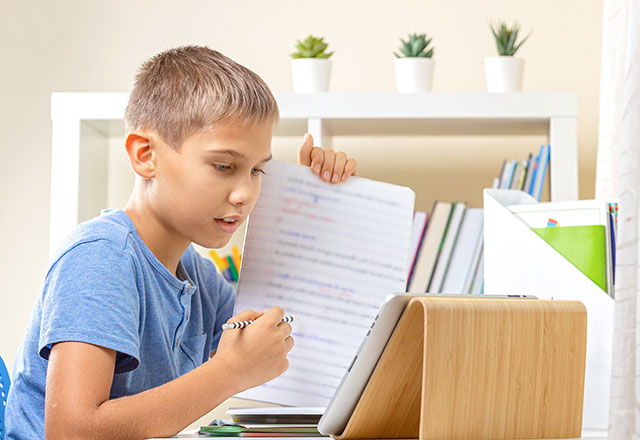
This school year has presented many uncertainties for teachers as they continue to navigate virtual, hybrid, and in-person learning environments. Using clear and positive communication can build trusting and supportive teacher-student relationships, especially with students who experience behavioral challenges. But what exactly does effective educator-student communication look like, particularly in a virtual space? Below, we highlight some research-based practices that educators can use in any setting.
Set clear behavioral expectations
Educators frequently provide guidance and instruction throughout the school day regardless of the educational setting. Behavioral expectations may look different these days, such as maintaining six feet of distance between peers or muting microphones during a virtual lesson. With limited visual cues and body language in virtual classrooms or behind a mask, students need explicit instructions that outline clear and concrete expectations. This helpful resource includes important guidelines that can help educators provide clear guidance, such as the following:
- Keep instructions as brief as possible. Provide directions one step at a time and ensure that students understand the instructions by pausing and providing time for students to ask questions.
- Use a matter-of fact, business-like tone. Keep calm and avoid power struggles. Take a deep breath before responding to students and feel comfortable remaining in silence, if necessary.
- State the expectation as a directive, not a question. Phrasing expectations as a question (“Can you mute your audio?”) may give students the option to decline. If a student needs to do something, make that clear (“Please mute your audio and use the chat”).
- Avoid long explanations or justifications. If a brief explanation is necessary, provide it before stating the expectation. Keep the guidance clear and refrain from giving more details than needed.
- “Wait time” is not just an academic strategy! Give students an appropriate amount of time to demonstrate appropriate behavior. This is another instance where taking a deep breath might be helpful! Try to avoid providing too many prompts or adding steps to the expectation while waiting for the student to demonstrate appropriate behavior.
Outlining clear expectations is a critical component of providing effective instructions and promoting positive communication between students and teachers. As simple as it may sound, for a student to behave appropriately, it is helpful to focus on exactly what they should be doing, instead of what they shouldn’t be doing. Sometimes changing the wording of a request can provide students with guidance on the appropriate behavior and can increase the likelihood they will demonstrate competency.
Emphasize appropriate behaviors in your directions. For example:
Instead of saying, “I won’t help you if you don’t go back to your seat,” change the phrase to, “I will help you when you get back to your seat.”
Similarly, try asking students to “start” an appropriate behavior instead of “stopping” and inappropriate behavior. In a virtual setting, instead of saying, “Stop yelling out your answers,” say, “Be sure to use the chat box so I can hear from everyone.”
Provide recognition for appropriate behavior
Students and teachers alike are facing an unprecedented amount of stress during the COVID‑19 pandemic. This may contribute to an increase in inappropriate behaviors in physical or virtual classroom settings; however, there are ways for teachers to remain encouraging and focused on appropriate behavior. When students follow instructions, it is important to give them positive reinforcement in the form of specific behavioral praise. Aim to maintain a ratio of five positive comments to every reprimand or corrective comment (5:1) when interacting with a student. Sometimes, when it seems like a student is mostly engaging in inappropriate behaviors, it can be tricky to provide positive recognition, but try to “catch them being good.” Finding positive things to say and providing effective praise can improve interactions and, ultimately, the students’ behaviors. The tips below can help you provide praise that is meaningful, specific, and tied to concrete behaviors:
- Be genuine. Meaningful praise is sincere and not exaggerated.
- Use specific language about concrete behaviors. Describe exactly what students did well so they know the appropriate behavior you want them to repeat. For example, acknowledging “Great job logging into our video lesson on time and with your work complete!” is more specific and concrete than saying “You did a good job this morning!”
- Praise hard work and effort to foster a growth mindset. Instead of praising natural talents or skills (“You are excellent at math!”), focus on student’s efforts and achievements (“I am impressed by how carefully you read the word problem and the strategies you used to try to solve it.”)
Praise students’ effort in the face of challenges. For example:
If a student who typically struggles with reading shows noncompliant behaviors during reading lessons, you could praise their efforts by saying “Great job following directions and getting your reading materials out for our next lesson.” This will encourage their engaging in even a challenging task.
Even in a virtual setting, you can provide non verbal praise by giving students a thumbs up or quick smile when they engage in positive behaviors.
Using these simple communication strategies can go a long way in virtual, hybrid, and in-person educational environments. Interested in learning more?
- This resource from Michigan’s MTSS Technical Assistance Center provides additional tips for encouraging positive student behavior in virtual learning environments.
- Our previous Student Behavior blog post lists five strategies educators can use in a virtual setting to support students experiencing trauma during COVID-19.
- Another previous Student Behavior blog post provides teachers’ perspectives on distance learning approaches and includes five recommendations for a successful fall semester.
- Another great resource is the Reducing Behavior Problems in the Elementary School Classroom practice guide developed by the What Works Clearinghouse in the U.S. Department of Education.
Stay tuned! In an upcoming post, we’ll highlight additional strategies for supporting students, particularly those who exhibit challenging behaviors.
Topics: School-wide prevention Social–emotional and behavioral challenges
